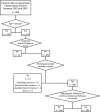Injury complexity factors predict heterotopic ossification restricting motion after elbow trauma
- PMID: 24078170
- PMCID: PMC4048434
- DOI: 10.1007/s11999-013-3304-0
Injury complexity factors predict heterotopic ossification restricting motion after elbow trauma
Abstract
Background: Heterotopic ossification (HO) is a common extrinsic cause of elbow stiffness after trauma. However, factors associated with the development of HO are incompletely understood.
Questions/purposes: We retrospectively identified (1) patient-related demographic factors, (2) injury-related factors, and (3) treatment-related factors associated with the development of HO severe enough to restrict motion after surgery for elbow trauma. We also determined what percentage of the variation in HO restricting motion was explained by the variables studied.
Methods: Between 2001 and 2007, we performed surgery on 417 adult patients for elbow fractures; of these, 284 (68%) were available for radiographs at a minimum of 4 months and clinical review at a minimum of 6 months after surgery (mean, 7.9 months; range, 6–31 months). HO was classified according to the Hastings and Graham system. Patients with HO restricting motion (defined as a Hastings and Graham Class II or III) were compared with patients without HO restricting motion in terms of demographics, fracture location, elbow dislocation, open wound, mechanism of injury, ipsilateral fracture, head trauma, time from injury to surgery, number of surgeries within 4 weeks, total number of surgeries, bone graft, and infection, using bivariate and multivariable analyses. A total of 96 patients had radiographic HO, and in 27 (10% of those available for followup), it restricted motion.
Results: There were no patient-related demographic factors that predicted the formation of symptomatic HO. Ulnohumeral dislocation in addition to fracture (odds ratio, 2.38; 95% CI, 1.01–5.64; p = 0.048) but not fracture location was associated with HO. Longer time from injury to definitive surgery and number of surgical procedures in the first 4 weeks were also independent predictors of HO (p = 0.01 and 0.004, respectively). These factors explained 20% of the variance in risk for HO restricting motion.
Conclusions: HO restricting motion after operative elbow fracture treatment associates with factors that seem related to injury complexity, in particular, ulnohumeral dislocation, delay, and number of early surgeries; however, a substantial portion of the variation among patients with elbow fracture who develop restrictive HO remains unexplained.
Level of evidence: Level III, therapeutic study. See Instructions for Authors for a complete description of levels of evidence.
Figures
References
-
- Ahrengart L. Periarticular heterotopic ossification after total hip arthroplasty: risk factors and consequences. Clin Orthop Relat Res. 1991;263:49–58. - PubMed
-
- Evans EB, Smith JR. Bone and joint changes following burns; a roentgenographic study; preliminary report. J Bone Joint Surg Am. 1959;41:785–799. - PubMed
MeSH terms
LinkOut - more resources
Full Text Sources
Other Literature Sources
Medical
Research Materials


